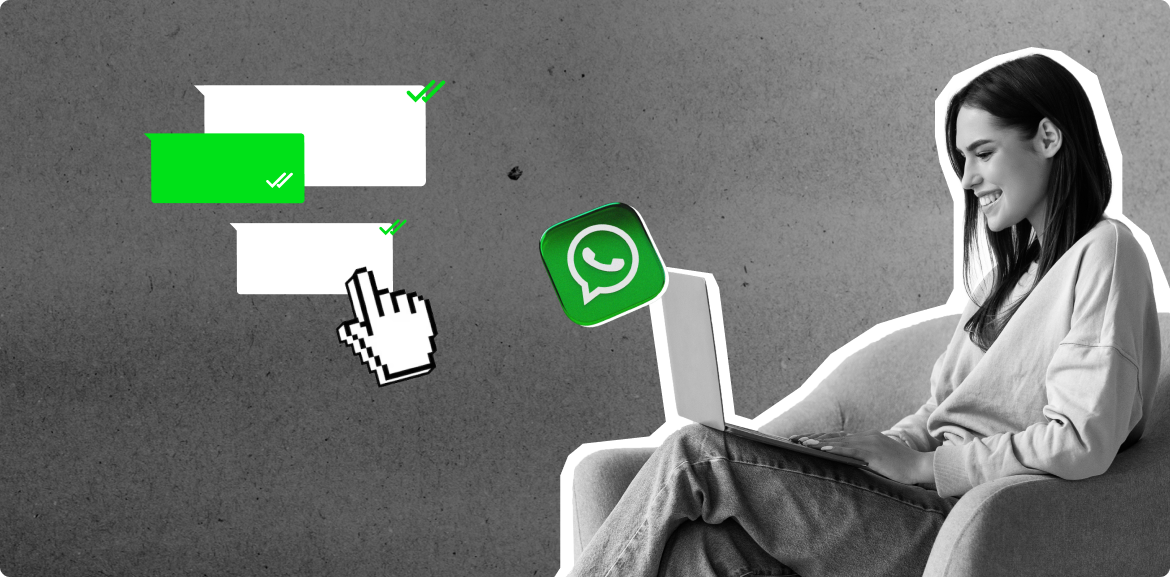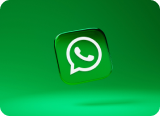Click-to-WhatsApp Ads – All You Need to Know

The benefits of WhatsApp as a marketing, sales, and customer support tool for brands is well-known. But in order to be able to harness its potential, brands need to let shoppers know they are available on the app. A business is not searchable on WhatsApp, so there are other ways in which brands can let customers know they are available to chat. One of the best ways to announce their WhatsApp presence is to leverage click-to-WhatsApp ads.
What Are Click-to-WhatsApp Ads?
They are a type of advertising that allow businesses to connect directly with customers through WhatsApp. These ads are typically run on social media platforms like Facebook and Instagram, given that Facebook (Meta Platforms, Inc.) owns WhatsApp. The main goal of click-to-WhatsApp ads is to facilitate a seamless transition from an ad to a personal conversation on WhatsApp, making it easier for businesses to engage with customers and prospects. These ads, which are essentially entry points for customers to start conversations with a brand on WhatsApp, include a call-to-action (CTA) button that, when clicked, opens a chat window with the business. The ad can be designed to promote a product, service, or event, or simply to encourage customers to engage in a conversation. When users click the CTA, they are redirected to WhatsApp, where a pre-set message created by the business may appear to initiate the conversation. The initial message can be customized by the business to prompt a specific response or guide the conversation. This helps streamline interactions and makes it easier for the business to manage customer inquiries.
What Are Some Benefits of Using Click-to-WhatsApp Ads?
- Direct Engagement: These ads allow businesses to start a conversation with potential customers directly. The embedded Send Message button in the ad, once clicked on, opens a conversation thread in the WhatsApp Business app automatically, bringing the customer into direct contact with the company. This direct, personal interaction can lead to higher engagement rates compared to traditional ads.
- Convenience: For customers, the transition from seeing an ad to chatting with a business on a familiar platform like WhatsApp is seamless and convenient, enhancing the user experience.
- Higher Conversion Rates: Direct communication with customers who have voluntarily clicked on the link help a business generate higher quality leads that typically lead to better conversion rates.
- Cost-Effective: Click-to-WhatsApp ads can be more cost-effective than other forms of digital advertising, especially for small to medium-sized businesses looking to increase interaction without a significant investment.
How to Set Up Click-to-WhatsApp Ads?
To do this, you need to first connect your WhatsApp Business API account to your Facebook page. For this, you need to open your company’s Facebook business Page and click on Settings. Next, in the column on the left-hand side, select WhatsApp. Next you need to select your country code, enter your WhatsApp Business Platform phone number, and send a request to connect the number with your Facebook account. Once the request to connect is accepted, your Facebook Page will be connected with the WhatsApp Business platform account. You can see the connected phone number in the Settings tab of your Facebook Page. You can add a Send message button to your Facebook or Instagram ads. When your customers click the button, it will start a conversation thread in WhatsApp where your customers can connect with you.
How to Measure the Effectiveness of Click-to-WhatsApp Ads?
Measuring the effectiveness of Click-to-WhatsApp ads involves tracking key performance metrics that reflect both the interaction with the ad and the outcomes from the WhatsApp conversations initiated. Here’s how you can assess its effectiveness:
1. Click-Through Rate (CTR): This shows the percentage of people who clicked on an ad to initiate a conversation on WhatsApp. A high CTR indicates that the ad has resonated with the audience and is generating interest.
2. Cost Per Click (CPC): This measures the amount a brand pays each time someone clicks on the ad to start a WhatsApp chat. Monitoring CPC helps to understand the cost-effectiveness of the ad spend.
3. Conversion Rate: This measures the percentage of WhatsApp conversations that lead to a desired action, such as a purchase or lead submission. It provides a direct measure of how successful the ad is in driving results after initiating a chat.
4. WhatsApp Chat Initiation Rate: This measures the number of people who not only click on the ad but actually initiate a chat. Not everyone who clicks the ad will send a message, so tracking this metric helps to assess the engagement quality.
5. Cost Per Acquisition (CPA): This measures the cost of acquiring a customer through the WhatsApp chat initiated from the ad. It helps a brand calculate the return on investment (ROI) of their Click-to-WhatsApp ads by relating the cost of the campaign to actual sales or leads.
6. Response Time: This is the average time it takes for a team to respond to inquiries initiated via the ad. A fast response time can improve customer satisfaction and increase conversion rates.
7. Engagement Quality: This measures the depth of the conversations initiated (e.g., number of messages exchanged, the content of the messages). High-quality engagements tend to correlate with better sales outcomes and stronger customer relationships.
8. Customer Feedback and Satisfaction: This shows the feedback from users after interacting with a brand via WhatsApp. Customer satisfaction and feedback collected via post-chat surveys or follow-ups can provide insights into the effectiveness of the customer service provided and the ad’s appeal.
9. Return on Ad Spend (ROAS): This measures the revenue generated from the WhatsApp conversations compared to the ad spend. It shows the profitability of the ad and helps assess whether it’s a sustainable advertising channel.
10. Message Volume: This measures the total number of messages received through the ad. It helps the brand gauge the ad’s success in driving engagement.

How Are Such Conversations Charged?
As per Meta’s documentation, when a user contacts a business through a Click-to-WhatsApp ad, the business can reply with template messages within a 24-hour window and continue sending template messages free of charge for up to 72 hours after that. Conversations started through Click-to-WhatsApp ads are considered free entry-point conversations. This allows businesses to save significant costs that would typically be spent on marketing-related interactions. The cost of each marketing conversation varies based on the region or country where your business operates (look up Meta’s official documentation for the specific rates). However, businesses can bypass these conversation fees by utilizing Click-to-WhatsApp ads to attract clients, rather than using alternatives like QR codes or WhatsApp links.
How to Craft the Perfect Copy for Click-to-WhatsApp Ads?
Crafting the perfect copy for Click-to-WhatsApp ads involves creating a message that not only grabs attention but also encourages users to take immediate action by initiating a conversation. Here’s a step-by-step guide to creating effective ad copy for this type of ad:
1. Start with a Hook: Grab attention within the first few words – use an intriguing question, a bold statement, or a relatable pain point. For example:
“Got questions about [product/service]? We’re here to help!”
“Struggling with [specific problem]? Let’s chat and find a solution.”
2. Highlight a Benefit: Make it clear why the user should take action and how your product or service can help them. By focusing on what the user gets out of the interaction, you encourage them to click. Focus on a specific benefit that directly addresses a pain point or need. Examples:
“Get personalized advice for [problem].”
“Unlock exclusive offers with a quick chat.”
3. Create Urgency: Encourage immediate action by creating a sense of urgency. Use time-sensitive language or limited offers to create FOMO (fear of missing out). Examples:
“Limited time offer – Chat with us now and get 10% off!”
“First 50 people to message us get free shipping!”
4. Incorporate a Clear Call to Action (CTA): Make it obvious what you want the user to do (click to start a conversation). Keep the CTA aligned with the purpose of the chat—whether it’s to provide information, close a sale, or offer customer support. Use straightforward and action-oriented language. Examples:
“Message us now to learn more.”
“Click to chat and get your questions answered.”
5. Build Trust with Reassurance: Ease any hesitation by providing reassurance. If possible, you can also include elements like guarantees, social proof, or customer testimonials to boost credibility. Use phrases that reduce anxiety about starting a conversation, such as:
“Chat with our friendly team – no pressure!”
“We’re here to help, no strings attached.”
6. Personalize the Message: Make the ad feel relevant and tailored to the audience. Use language that speaks directly to the target demographic or geographic location:
“Looking for [local service/product]? Chat with us for more info!”
“Hey [Target Audience], want to know how [your product] can help you today?”
7. Use Conversational Language: Encourage engagement by sounding approachable and human. Avoid overly formal or corporate language. Instead, use a friendly, conversational tone:
“Let’s chat! We’d love to hear from you.”
“Got a question? Shoot us a message, and we’ll get back to you ASAP!”
8. Test Emojis (if appropriate): Add a visual element to make your ad stand out. Emojis can make your ad feel more casual and engaging, but use them strategically to support the message:
“💬 Got a question? Message us now!”
“🎁 Exclusive offer: Chat with us for a special discount!”
9. Leverage the WhatsApp Icon or Mention: Make the connection with WhatsApp clear. Incorporate the WhatsApp logo or reference in your copy so users know that by clicking, they’ll be directed to chat on WhatsApp:
“Talk to us on WhatsApp now!”
“Click to start a chat on WhatsApp and get instant answers.”
10. A/B Test Different Copy Variations: Continuously improve the effectiveness of your ads by testing different elements. Create multiple variations of your copy and test which ones resonate better with your audience. Test different hooks, benefits, CTAs, and language tones to see what works best for the brand.




![[photo]](https://edna.io/wp-content/themes/edna/images/authors/rajrupa-ghoshal.jpg)
![[icon]](https://edna.io/wp-content/themes/edna/images/authors/ico-linkedin.svg)